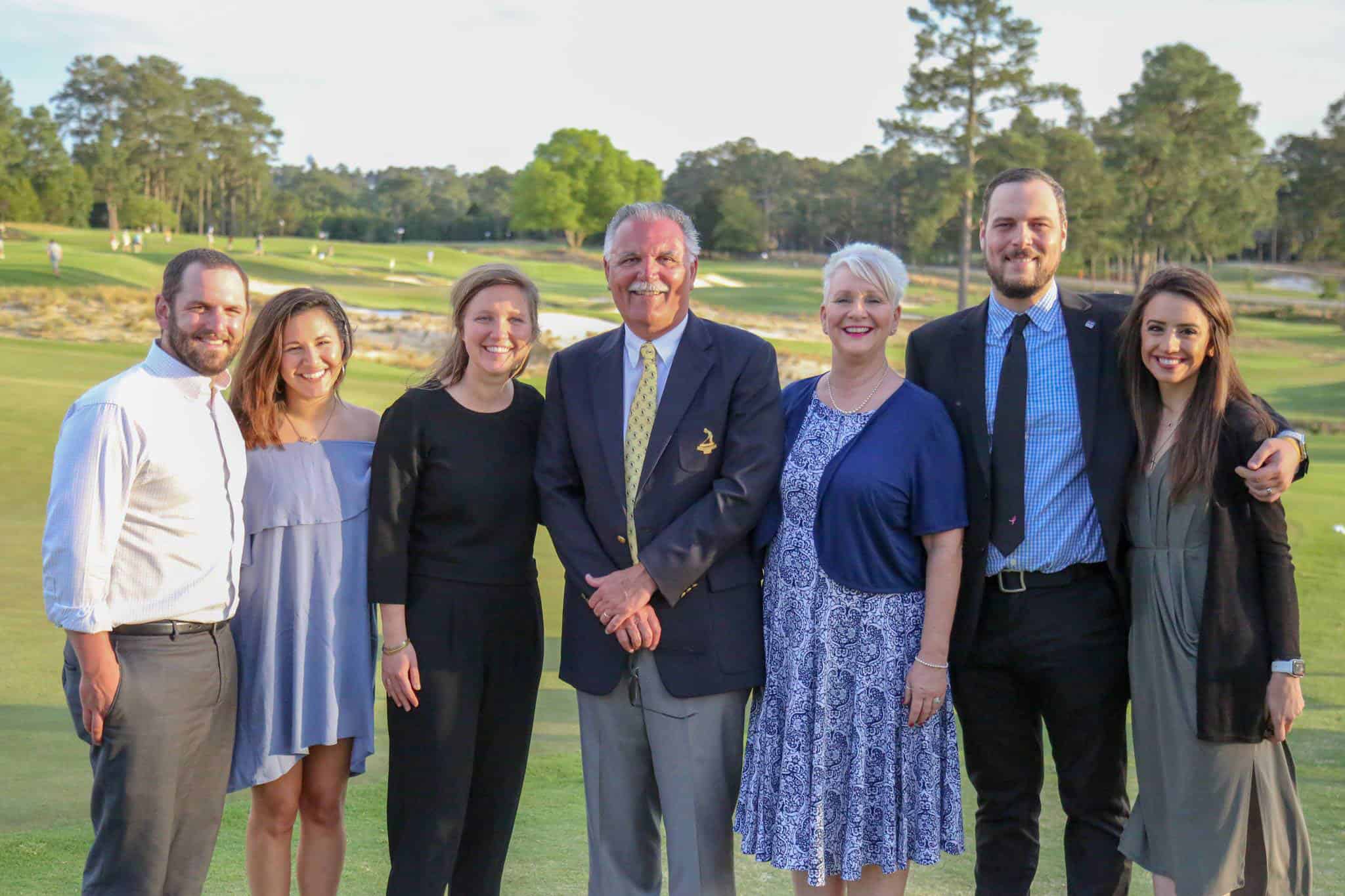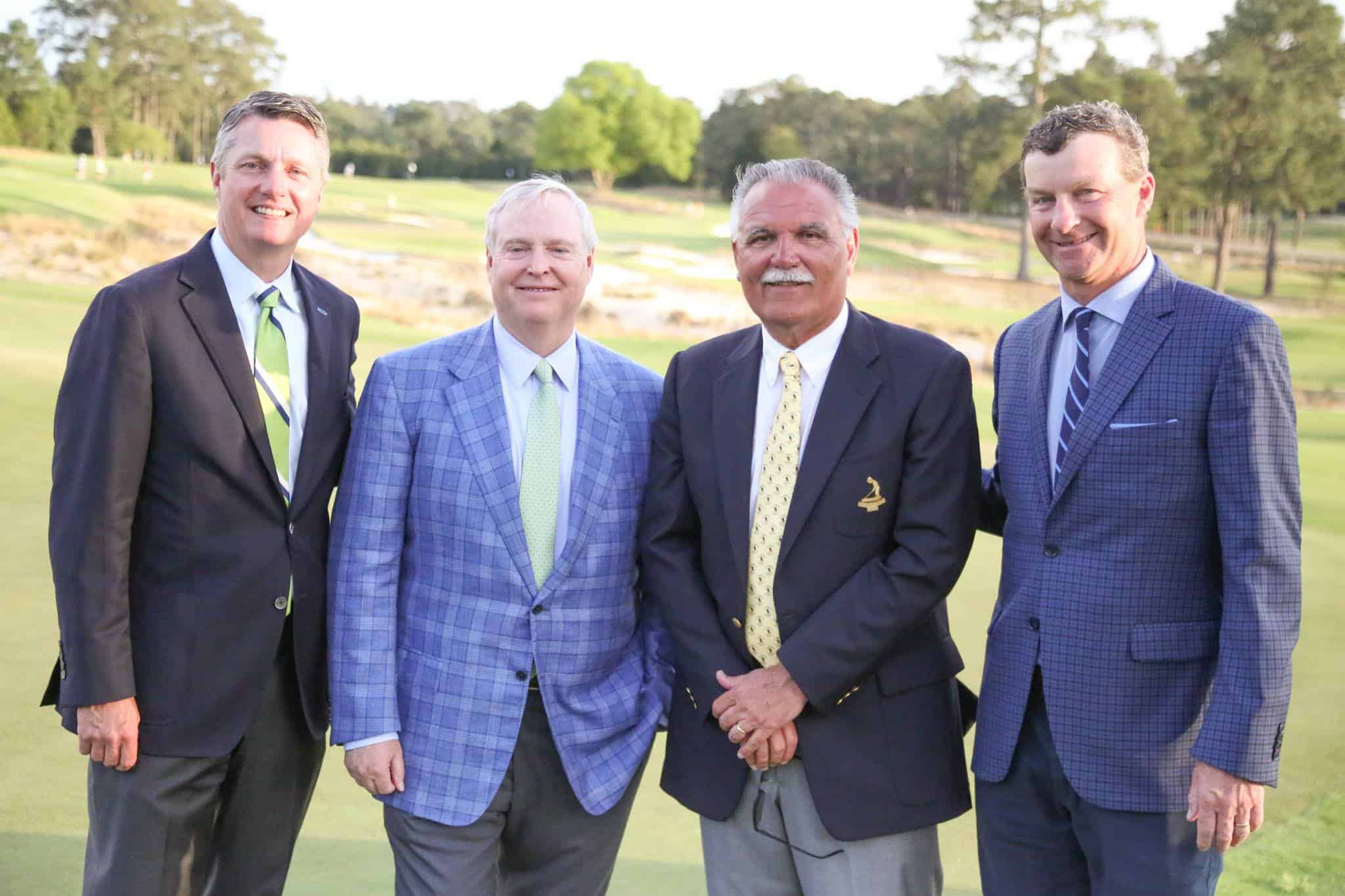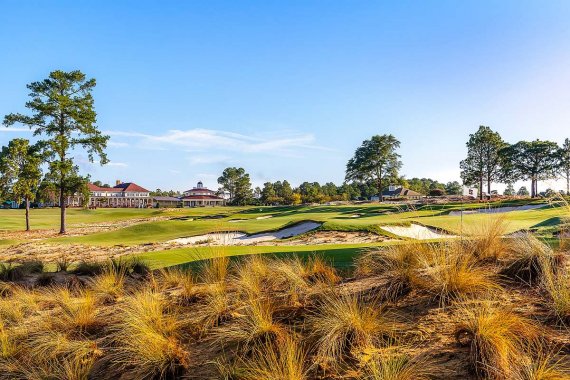Bob Farren gazed out across the banquet hall, 37 years into his tenure on the golf course grounds and maintenance staff at Pinehurst Resort and Country Club.
“First I would like to say, this is not a retirement speech,” Farren said to a round of laughter. “I have always been afraid that someday I would have to get a real job, and I don’t want to start right now.”
Farren is among those richest of men who’s enjoyed his work so much that it’s been difficult to distinguish between vocation and avocation. But make no mistake, the VP of Grounds and Golf Course Maintenance since 2008 and a grounds staff member since 1982 has discharged his duties so well that last Thursday night he was inducted into the Carolinas Golf Hall of Fame.

Bob Farren, center, is joined by friends and family (l-r) Christian Johnstone, Emily Johnstone, Kristin Farren, wife Kathy Farren, Casey Farren and Megan Farren.
“It’s a very special honor,” he said of becoming the third inductee in a formidable list of 80 individuals overall that at least began his career maintaining golf courses. Donald Ross, a 1981 inductee, came to America in 1899 as a green keeper and club maker before evolving into one of the game’s most esteemed course designers, and George Thompson, a 2006 inductee, was the long-time superintendent at the Country Club of North Carolina.
“Bob puts his heart and soul into everything he does,” says Pinehurst owner Robert Dedman Jr. “He’s special. I’m glad he’s not retiring. That’s good news.”
Farren is a native of Welch, W.Va., and grew up in the golf business as his father was a superintendent at a public course less than a mile from the Farren home.
“I was always riding my bike back and forth,” Farren says. “I started working around my dad as soon as I was old enough. So it was in my DNA.”
Farren went to Marshall University to study recreation and tourism and graduated in 1979, all the while keeping his eye on the golf industry. He attended a Golf Course Superintendents Association of America meeting in San Antonio his junior year and heard a presentation from the chief superintendent at Pinehurst, and that planted the seed for him to apply for a job at Pinehurst in 1982. He was hired and became a certified superintendent in 1985. When Brad Kocher retired as the top maintenance official at Pinehurst in 2008, Farren was elevated to replace him. Today he marvels at the evolution of the superintendent’s role in the industry over nearly four decades.
“Today, we’re viewed as an important resource at a golf facility,” Farren says. “From a business perspective, what superintendents do and how they impact the bottom line are crucial for clubs and courses. Generally speaking, superintendents manage the largest budget and manage the most people at a facility. And they are problem-solvers and task-managers, too.”
Don Padgett II, the Pinehurst president from 2004-14, and Tom Pashley, the current president, laud Farren for his inherent good nature, imagination and creativity in helping Pinehurst maintain its position as the “St. Andrews of American Golf.”

Bob Farren, second from right, is joined by Pinehurst President Tom Pashley, Pinehurst CEO and Owner Bob Dedman, Jr., and Gil Hanse, who designed The Cradle and redesigned Pinehurst No. 4.
Padgett remembers promoting Farren in the fall of 2008 when the stock market was in free-fall and leisure and corporate travelers were significantly curtailing golf and travel spending.
“What a time,” Padgett says. “We lost 40 percent of our revenue in one year. Everyone wondered, ‘Where’s the bottom?’ Bob sat in my office in our first meeting. He said, ‘What you want me to do?’ I told him, ‘Cut as much as you can and keep us going.’”
Among Farren’s initiatives were to analyze “out-of-play” areas on the golf courses where manpower and fuel could be saved by letting those areas go and not affect play.
“Bob figured out how many man-hours and how much fuel we could save,” Padgett says. “He got to a number that was far better than I thought it could be. He showed a lot of original thinking. He made that number go down significantly.
“I was impressed because my CFO was happy.”
Padgett counts 87 at holes at Pinehurst that have evolved by one means or another since Farren joined the team in 1982, holes that came under Farren’s domain through helping manage conception, construction and/or maintenance.
- Course No. 7 was built in 1986 (18 holes).
- Course No. 8 was built in 1996 (18 holes).
- Course No. 9 was acquired in 2014 (18 holes).
- Course No. 4 was completely rebuilt in 2018 (18 holes).
- The Cradle Short Course was built in 2017 (nine holes).
- Four holes on No. 3 and one new hole on No. 5 were adjusted or built in 2017 to accommodate the holes on those courses lost to land now occupied by the Cradle (five holes).
- And one new hole was built on No. 1 in 2013 to allow the old 18th to become part of a new short-game practice area before the 2014 U.S. Open (one hole).

“None of those holes were here when Bob Farren came to Pinehurst,” Padgett says. “That’s pretty impressive. Not even Donald Ross touched that many holes. Bob’s played an integral part is what Pinehurst has been and what it is now.”
Pashley remembers Farren as having the kernel of an idea for what eventually became the Cradle, the nine-hole short course that has been embraced by members, guests and the golf world at large for bringing an element of fun and accessibility to the game that doesn’t exist at most golf clubs and destinations.
“Bob had the idea of adding some greens to the existing first holes of three and five, maybe placing them around the edges, tucking them behind bunkers, placing them where they would not interfere with play.,” Pashley said. “Then in the afternoons, you could talk about turning them into some sort of a par-three course. That was the seed of the idea. It was very creative, but the more we talked about it, the more we wanted a dedicated short-course experience.”
To build the Cradle on the site of the first holes of Nos. 3 and 5, though, you needed to work new holes into the existing courses on the west side of Hwy. 5. Farren led the effort to reconfigure existing holes and build new ones to make that happen.
“If Bob had said, ‘You’re crazy, we can’t relocate two par-four holes and find a way to have both No. 3 and 5 be challenging courses and quality golf experiences, the Cradle would have never happened,” Pashley says. “He could have shot that down easily and said it was not doable. But Bob having the open mind and creativity and vision to go figure out how to reconfigure some holes allowed the Cradle to happen.
“That to me is a perfect way to sum up his vision and creativity and open-mindedness that have served him so well over his career.”
Also inducted into the Hall of Fame in the ceremony in the Donald Ross Grill at Pinehurst were golf administrator Jim Hyler and golf architect George Cobb.
The Carolinas Golf Hall of Fame is housed in the East Wing Conference Center at the Carolina Hotel in Pinehurst and is administered by the Carolinas Golf Association, which is headquartered four miles away in Southern Pines.
Lee Pace has written about the golf courses and people of Pinehurst for more than three decades. His most recent book is “The Golden Age of Pinehurst—The Story of the Rebirth of No. 2” that was published in 2014.

